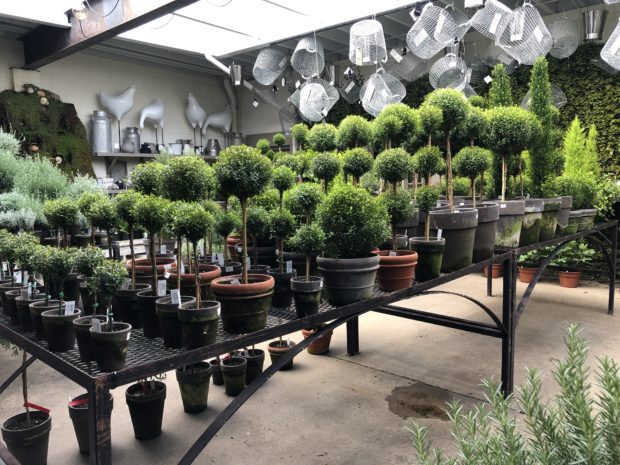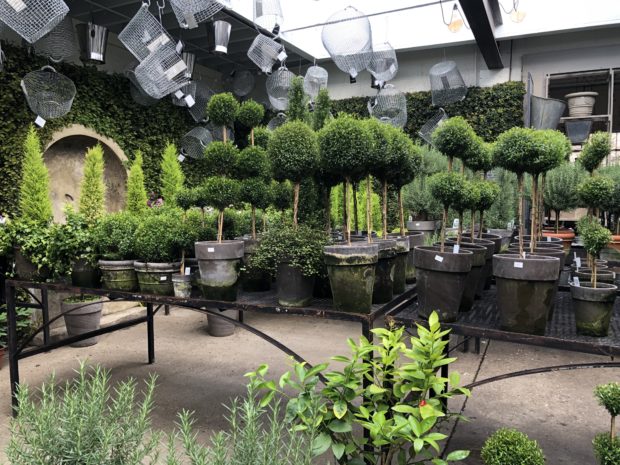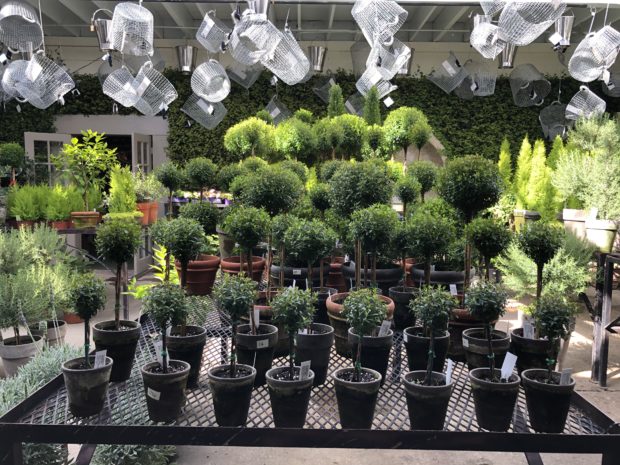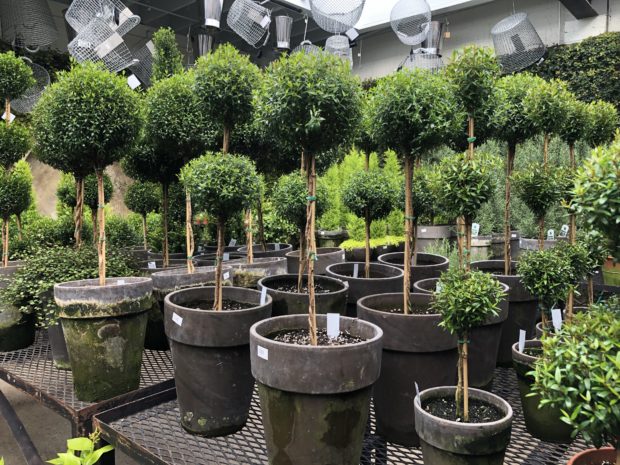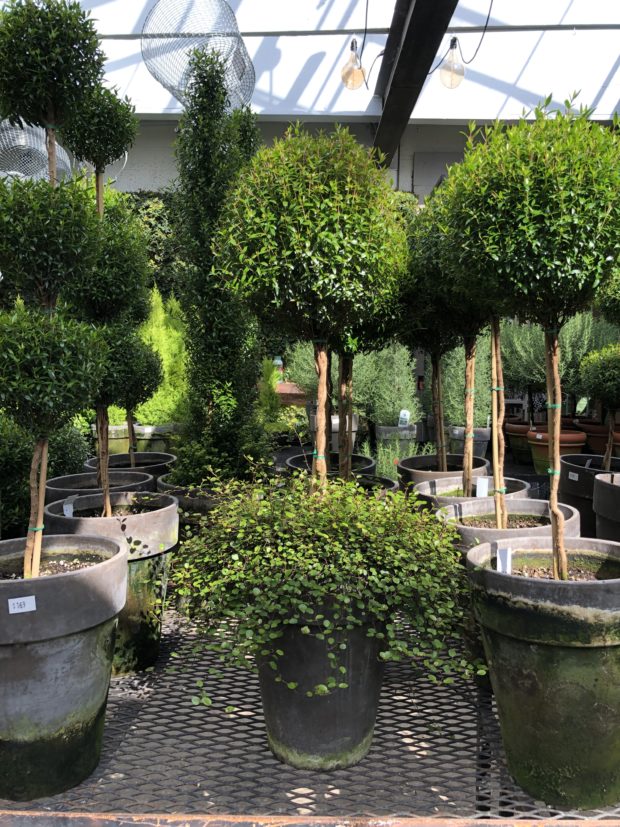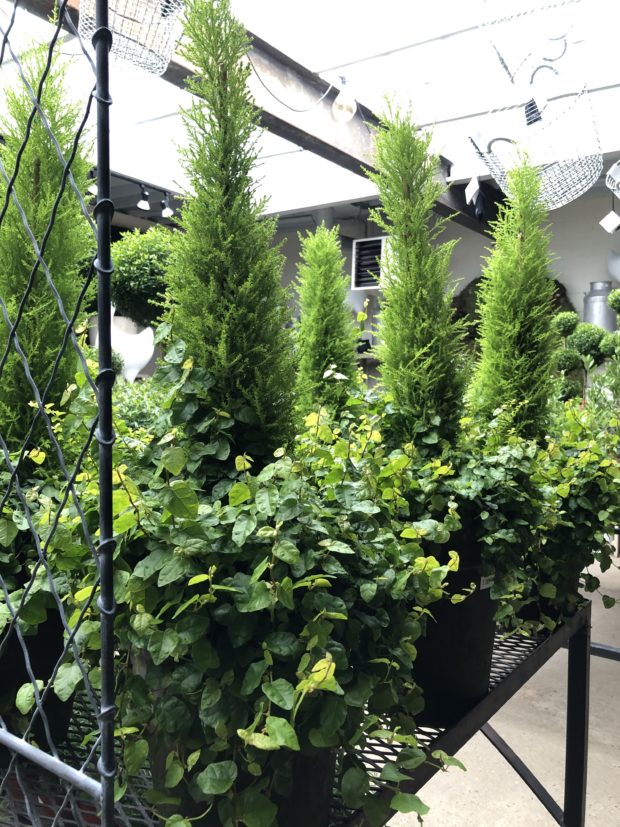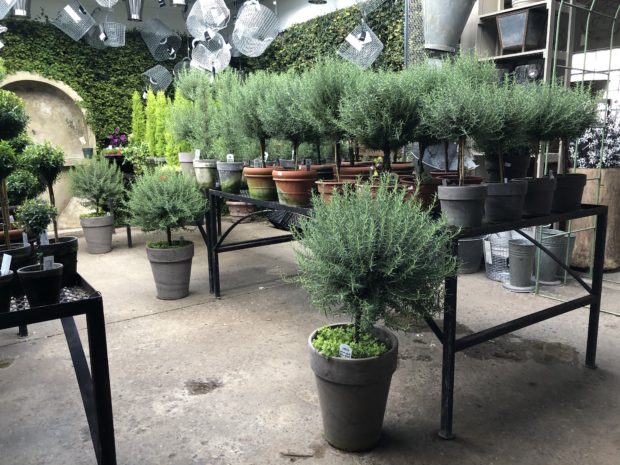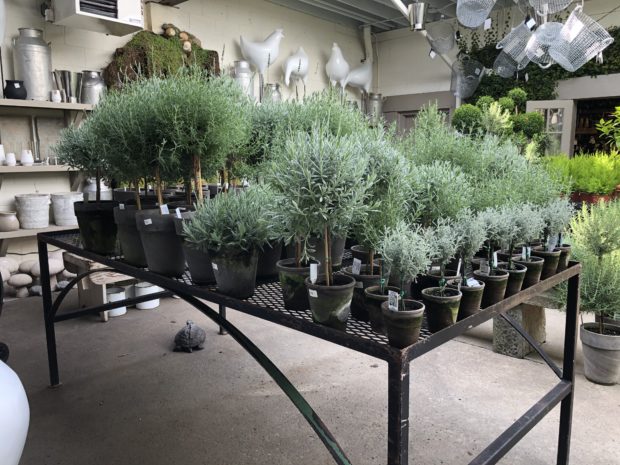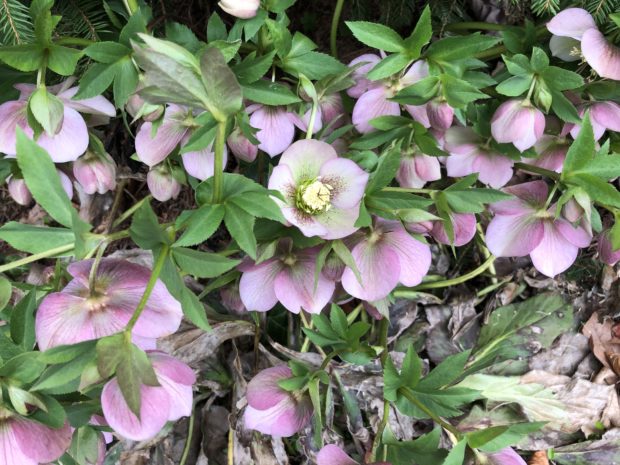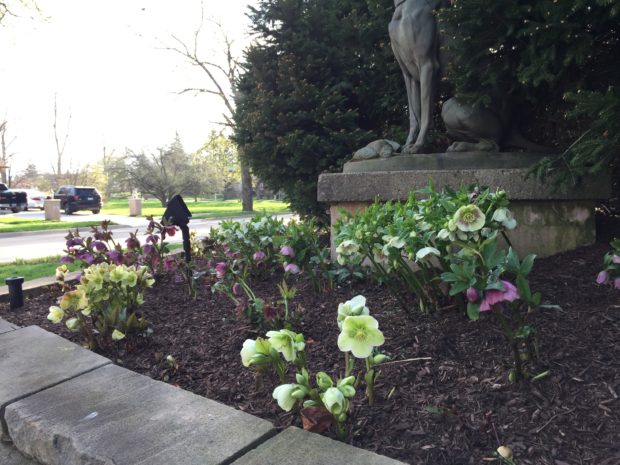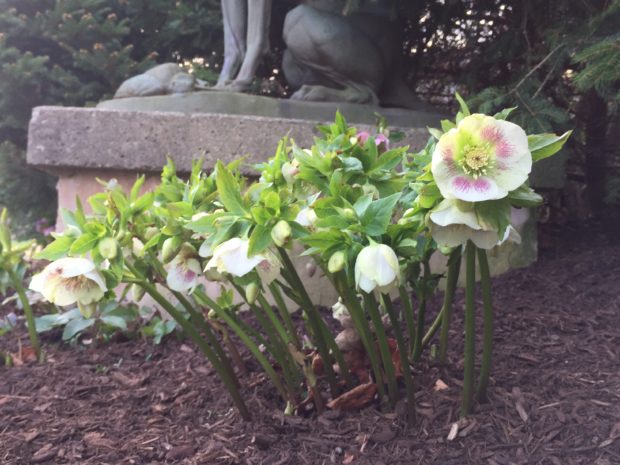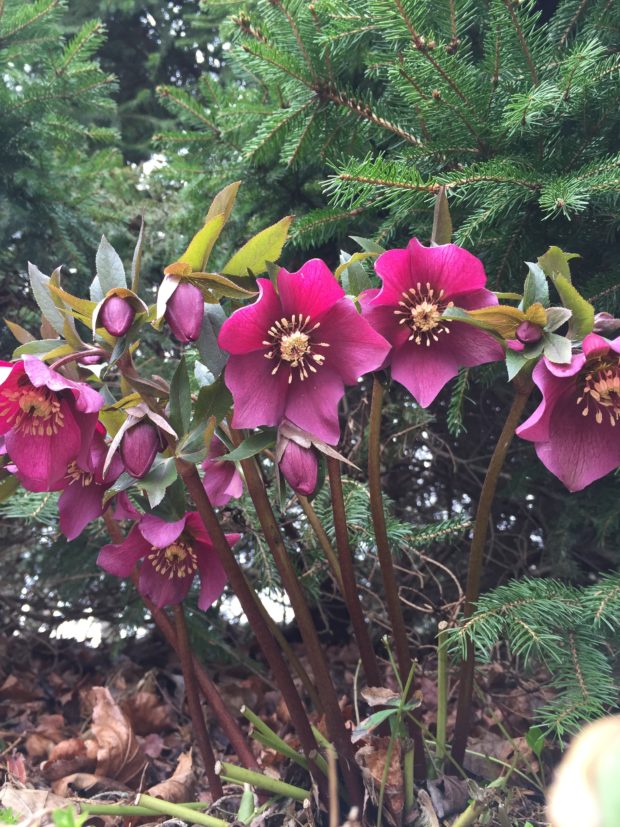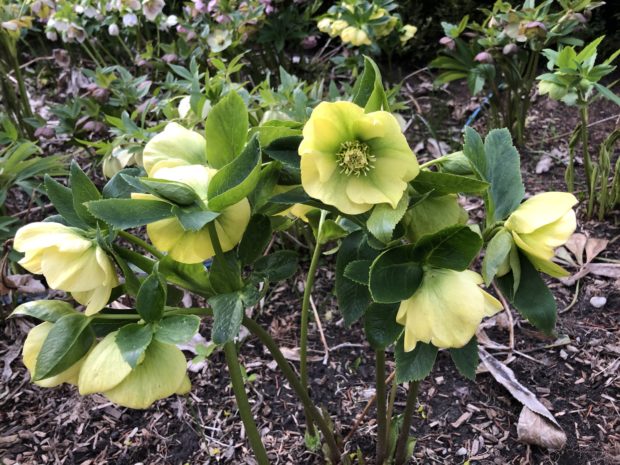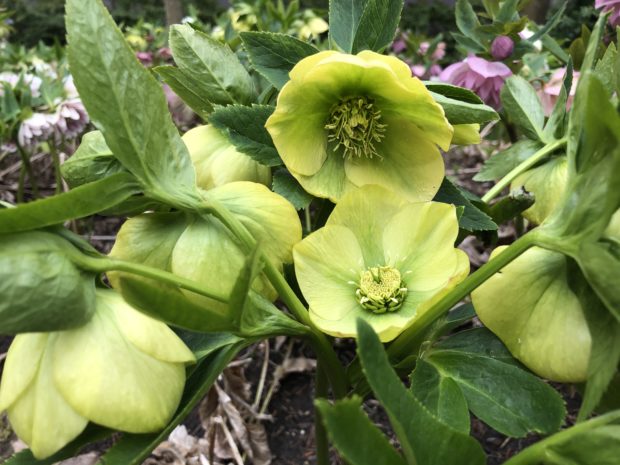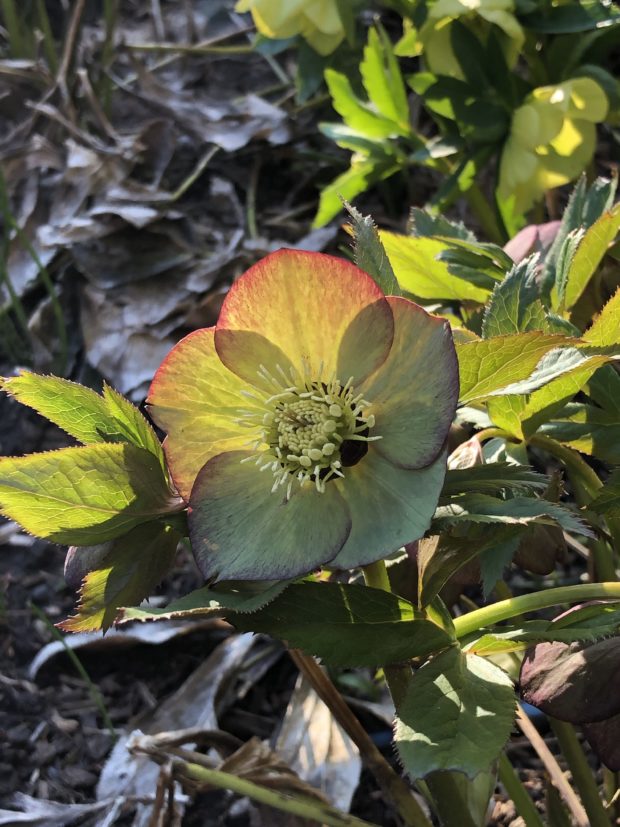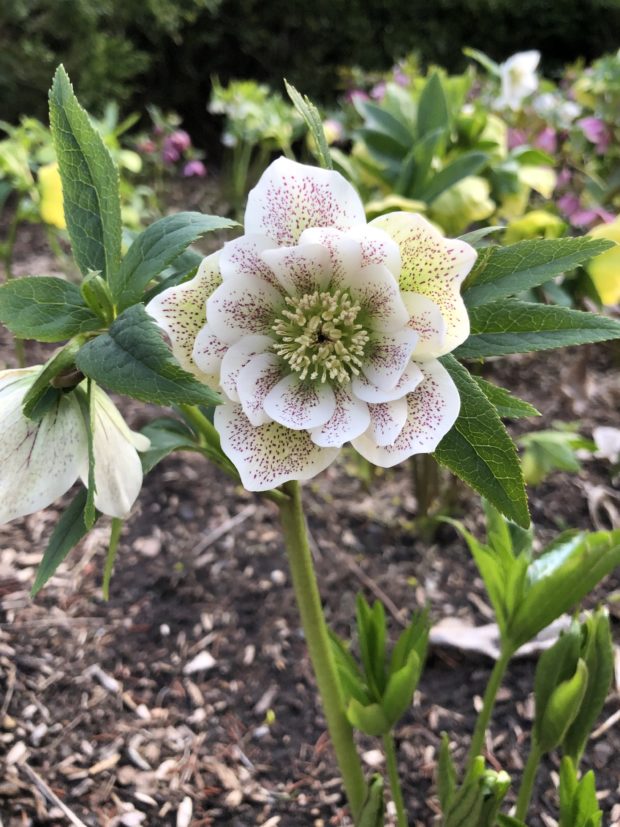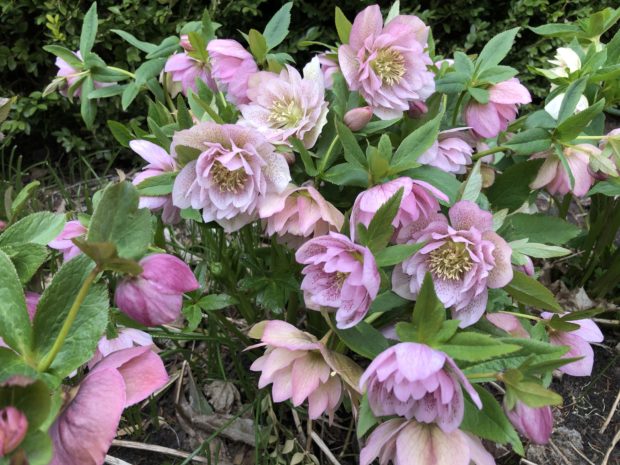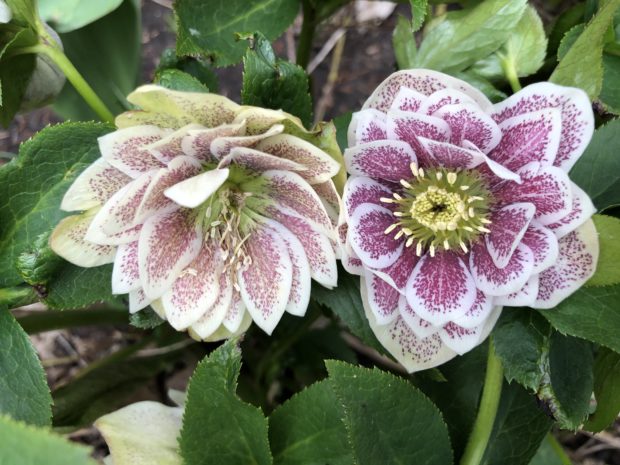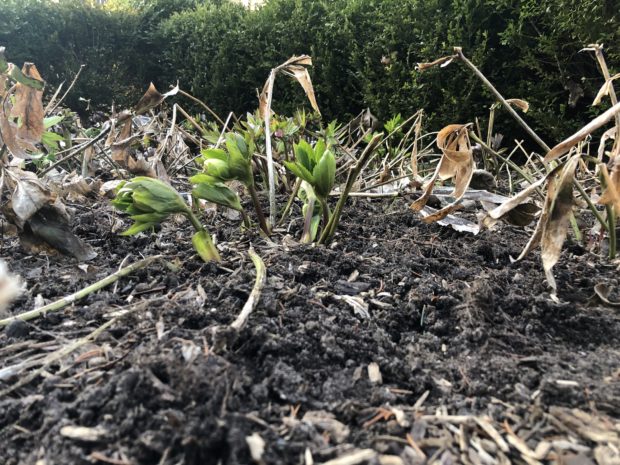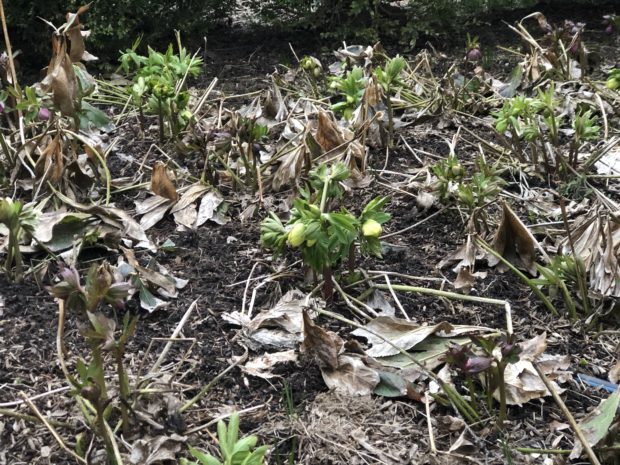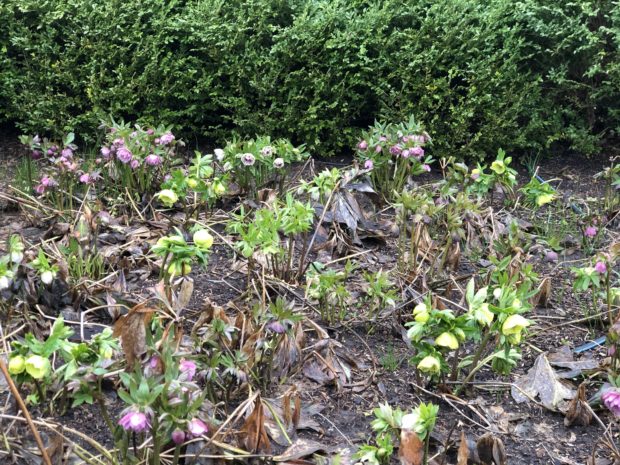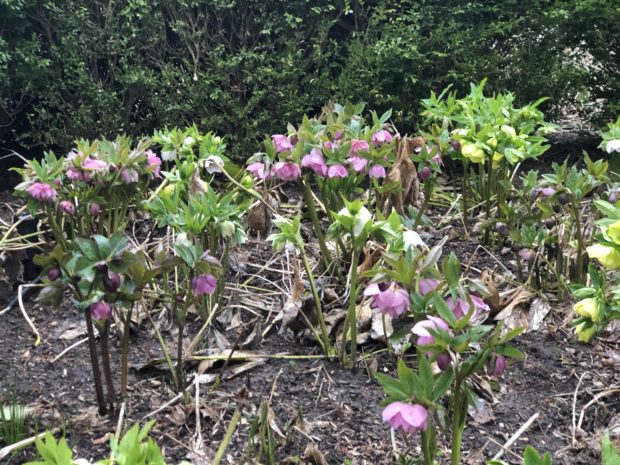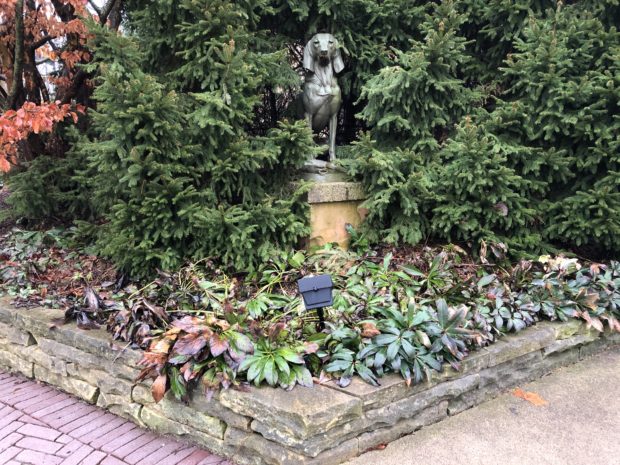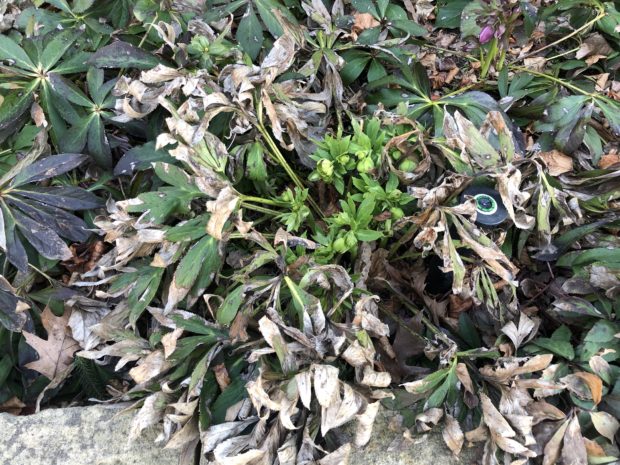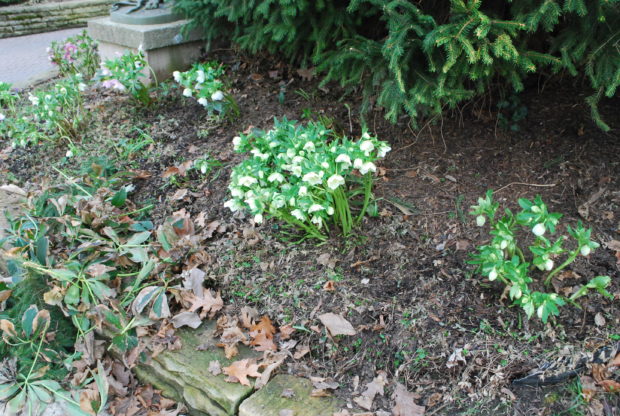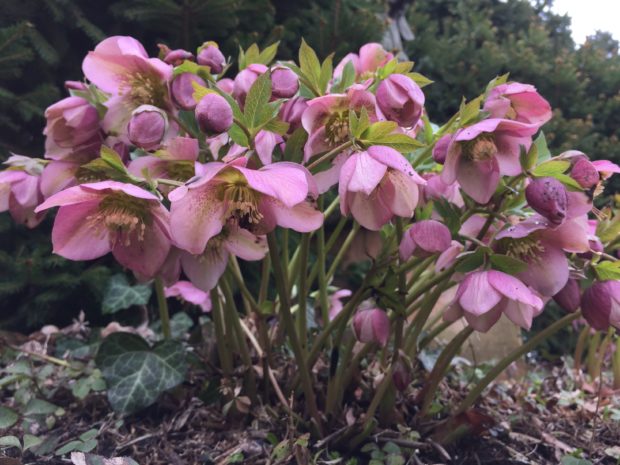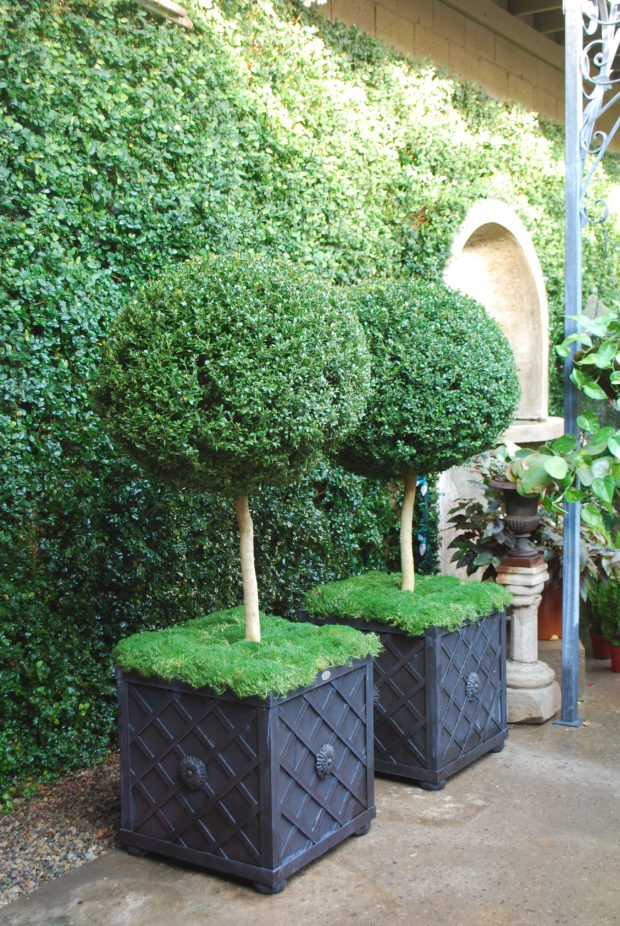 Anyone who chooses to look up topiary plants of distinction on their computer will find no end of articles with pictures of grand gardens featuring breathtaking topiary plants. Many of them have been cultivated long enough to have acquired shrine status. The size and scale of many of these topiary plants is staggering, never mind the work that is involved in keeping them up. I enjoy seeing them as much as the next person. But I also have great admiration for gardeners who on a more personal scale grow on plants that require a substantial and steady commitment to the maintenance. The single ball boxwood topiaries that are pictured above began as fairly modest plants grown at a farm specializing in boxwood in the Pacific Northwest. My memory is of a head diameter of perhaps 10 or 12 inches. The trunk would have been in the neighborhood of a quarter to a one half inch caliper. When these topiaries arrived, their trunks were secured to bamboo stakes virtually identical in size to the trunk, and as tall as the the stem and head. This is smart staking. The head of a topiary is the most vulnerable to catching the wind, and snapping off. Young topiaries are fragile. If you expect to grow them on, protect every part of them, bottom to the very top. I can’t say exactly how long we wintered these trees for my client, but it may have been 8 years or so. They summered in pots, and wintered in our unheated garage space. We were taking no chances with winter weather. Did we do the yearly pruning? No. We farmed that job out to an expert.
Anyone who chooses to look up topiary plants of distinction on their computer will find no end of articles with pictures of grand gardens featuring breathtaking topiary plants. Many of them have been cultivated long enough to have acquired shrine status. The size and scale of many of these topiary plants is staggering, never mind the work that is involved in keeping them up. I enjoy seeing them as much as the next person. But I also have great admiration for gardeners who on a more personal scale grow on plants that require a substantial and steady commitment to the maintenance. The single ball boxwood topiaries that are pictured above began as fairly modest plants grown at a farm specializing in boxwood in the Pacific Northwest. My memory is of a head diameter of perhaps 10 or 12 inches. The trunk would have been in the neighborhood of a quarter to a one half inch caliper. When these topiaries arrived, their trunks were secured to bamboo stakes virtually identical in size to the trunk, and as tall as the the stem and head. This is smart staking. The head of a topiary is the most vulnerable to catching the wind, and snapping off. Young topiaries are fragile. If you expect to grow them on, protect every part of them, bottom to the very top. I can’t say exactly how long we wintered these trees for my client, but it may have been 8 years or so. They summered in pots, and wintered in our unheated garage space. We were taking no chances with winter weather. Did we do the yearly pruning? No. We farmed that job out to an expert.
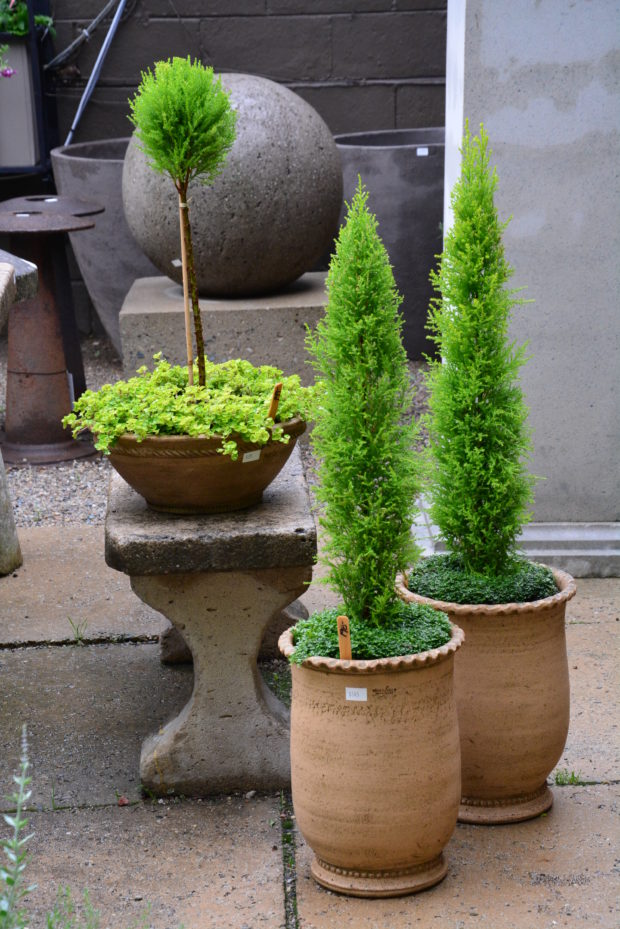 These topiary starts of lemon cypress- cupressus macrocarpa Goldcrest “Wilma” will top out at 3 feet or so. Outdoors, in a zone 7 or warmer, Goldcrest can grow to 16′ tall or so. The dwarf version Wilma makes a good house plants, provided they have a really sunny south facing location for at least 4 hours a day over the winter. They like cool temperatures, so wintering them over in a house kept at 72 degrees can be a tough go. Like most cypress, they appreciate evenly moist soil. If you let the rootball dry out, you have lost the plant. It is the juvenile foliage that has the best lime green color, so regular trimming will preserve that color. They appreciate a summer outdoors, but I try for a full sun morning with a little protection from the worst of the afternoon sun. Be advised that each stem you trim will probably turn brown at the cut. But once that branch starts growing again, that cut mark will fade from view. This is a quick look at the care issues with lemon cypress. Should you have the idea to grow them, look up their culture on line, and read.
These topiary starts of lemon cypress- cupressus macrocarpa Goldcrest “Wilma” will top out at 3 feet or so. Outdoors, in a zone 7 or warmer, Goldcrest can grow to 16′ tall or so. The dwarf version Wilma makes a good house plants, provided they have a really sunny south facing location for at least 4 hours a day over the winter. They like cool temperatures, so wintering them over in a house kept at 72 degrees can be a tough go. Like most cypress, they appreciate evenly moist soil. If you let the rootball dry out, you have lost the plant. It is the juvenile foliage that has the best lime green color, so regular trimming will preserve that color. They appreciate a summer outdoors, but I try for a full sun morning with a little protection from the worst of the afternoon sun. Be advised that each stem you trim will probably turn brown at the cut. But once that branch starts growing again, that cut mark will fade from view. This is a quick look at the care issues with lemon cypress. Should you have the idea to grow them, look up their culture on line, and read.
 No topiary in our zone is more challenging to grow than a myrtle. Myrtis communis compacta is an evergreen shrub that is especially genial and tolerant of frequent pruning. What they are not tolerant of is dry soil. During the winter, they need bright light, and even moisture. Myrtle topiaries of the scale and size pictured above requires a passionate and faithful grower. I have not seen myrtle topiaries of this size and scale very often, but I can attest that these clients lavished no end of attention on them.
No topiary in our zone is more challenging to grow than a myrtle. Myrtis communis compacta is an evergreen shrub that is especially genial and tolerant of frequent pruning. What they are not tolerant of is dry soil. During the winter, they need bright light, and even moisture. Myrtle topiaries of the scale and size pictured above requires a passionate and faithful grower. I have not seen myrtle topiaries of this size and scale very often, but I can attest that these clients lavished no end of attention on them.
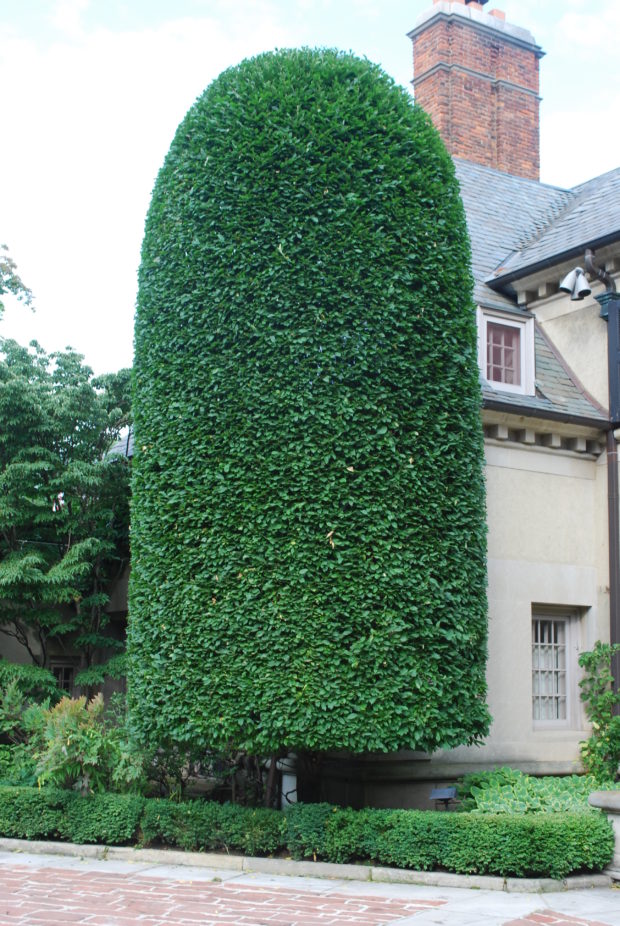 Certain trees are quite tolerant of close pruning. The carpinus pictured above has been expertly trimmed by a virtuoso with shears. I am quite sure there was a lift involved. They respond enthusiastically to pruning. This sheared shape is close to the natural shape of the tree, meaning the health of the tree is not endangered. A tree is a vast subject for a topiary, but the time between prunings can be fairly long. Linden trees are equally amicable about this kind of pruning. The boxed lindens on the driveway at Detroit Garden Works are pruned every other year at most.
Certain trees are quite tolerant of close pruning. The carpinus pictured above has been expertly trimmed by a virtuoso with shears. I am quite sure there was a lift involved. They respond enthusiastically to pruning. This sheared shape is close to the natural shape of the tree, meaning the health of the tree is not endangered. A tree is a vast subject for a topiary, but the time between prunings can be fairly long. Linden trees are equally amicable about this kind of pruning. The boxed lindens on the driveway at Detroit Garden Works are pruned every other year at most.
 Limelight hydrangeas make gorgeous single ball topiary plants. The loosely spherical head in full flower is quite spectacular. As hydrangeas are naturally very coarse growing plants, their shape is a study in contradictions. They are informally formal. Our grower trims the hydrangea standards twice a season. Once in late March or early April, and again later in May. This schedule helps to produce a strong network of branches that helps keep the flower heads aloft. Even so, we often tie up the branches with stretch tie, to make sure the framework is strong. The stake is as tall as the very top of the plant.
Limelight hydrangeas make gorgeous single ball topiary plants. The loosely spherical head in full flower is quite spectacular. As hydrangeas are naturally very coarse growing plants, their shape is a study in contradictions. They are informally formal. Our grower trims the hydrangea standards twice a season. Once in late March or early April, and again later in May. This schedule helps to produce a strong network of branches that helps keep the flower heads aloft. Even so, we often tie up the branches with stretch tie, to make sure the framework is strong. The stake is as tall as the very top of the plant.
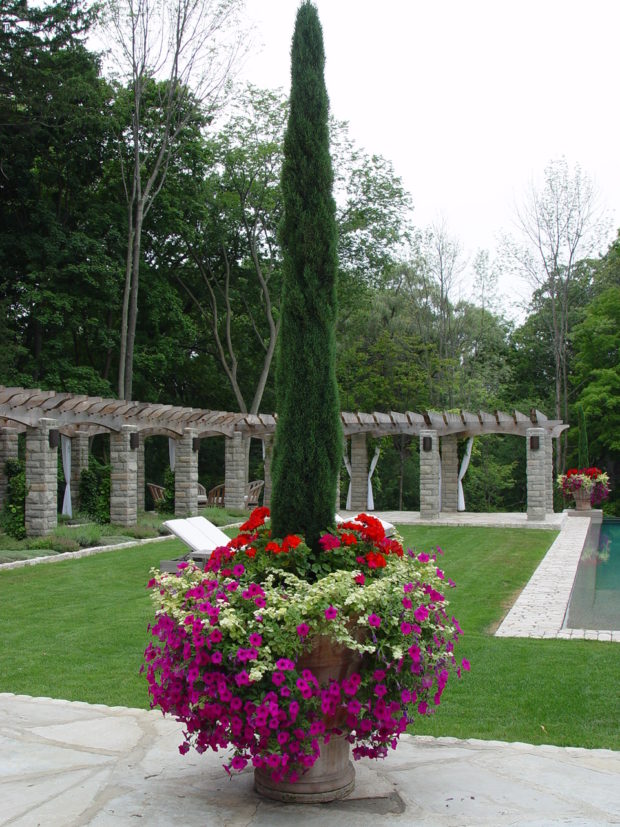 Italian cypress is not hardy in our zone-how I regret that. But if a client is willing to winter them over in an unheated greenhouse they can provide a dramatic focal point to a container for a number of years. This evergreen is naturally very narrow and conical, so the pruning required to keep them tight is a matter of emphasizing and more clearly defining what is already there.
Italian cypress is not hardy in our zone-how I regret that. But if a client is willing to winter them over in an unheated greenhouse they can provide a dramatic focal point to a container for a number of years. This evergreen is naturally very narrow and conical, so the pruning required to keep them tight is a matter of emphasizing and more clearly defining what is already there.
 This young boxwood topiary is delightfully under scaled for its under planting. The boxwood head has not been sheared, but left to its natural devices. It gives a very traditional landscape form a much more contemporary look.
This young boxwood topiary is delightfully under scaled for its under planting. The boxwood head has not been sheared, but left to its natural devices. It gives a very traditional landscape form a much more contemporary look.
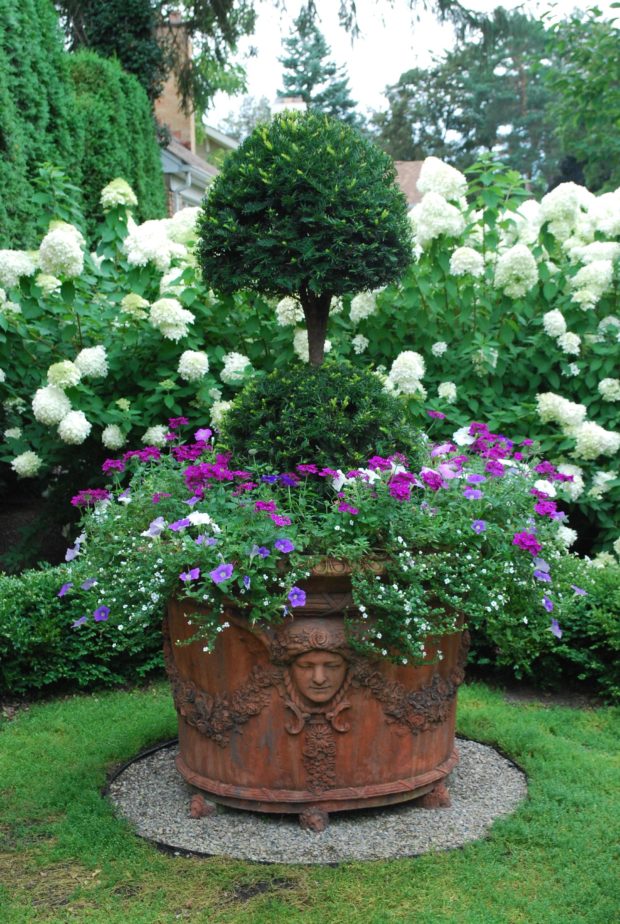 Yews make good topiary subjects, although they do not respond as well to close shearing. This double ball taxus lived for 4 years in this pot, all year round, before succumbing to a particularly cold winter. A little looser treatment produces a better looking plant. As in green through and through. Drastically sheared yews are common in the landscape, but the development of a topiary form is not a goal. It is a once a year effort to exert control over a plant that may be poorly sited. Improperly sheared yews sporting a thin skin of green, and bare branches and trunks underneath is not a good look. It also contributes to the decline and ill-health of the plant.
Yews make good topiary subjects, although they do not respond as well to close shearing. This double ball taxus lived for 4 years in this pot, all year round, before succumbing to a particularly cold winter. A little looser treatment produces a better looking plant. As in green through and through. Drastically sheared yews are common in the landscape, but the development of a topiary form is not a goal. It is a once a year effort to exert control over a plant that may be poorly sited. Improperly sheared yews sporting a thin skin of green, and bare branches and trunks underneath is not a good look. It also contributes to the decline and ill-health of the plant.  Junipers are rough coated evergreens, but they respond surprisingly well to pruning. They are also happy with a long term home in a large container. They are low maintenance shrubs and trees in general, so they shrug off the shearing.
Junipers are rough coated evergreens, but they respond surprisingly well to pruning. They are also happy with a long term home in a large container. They are low maintenance shrubs and trees in general, so they shrug off the shearing.
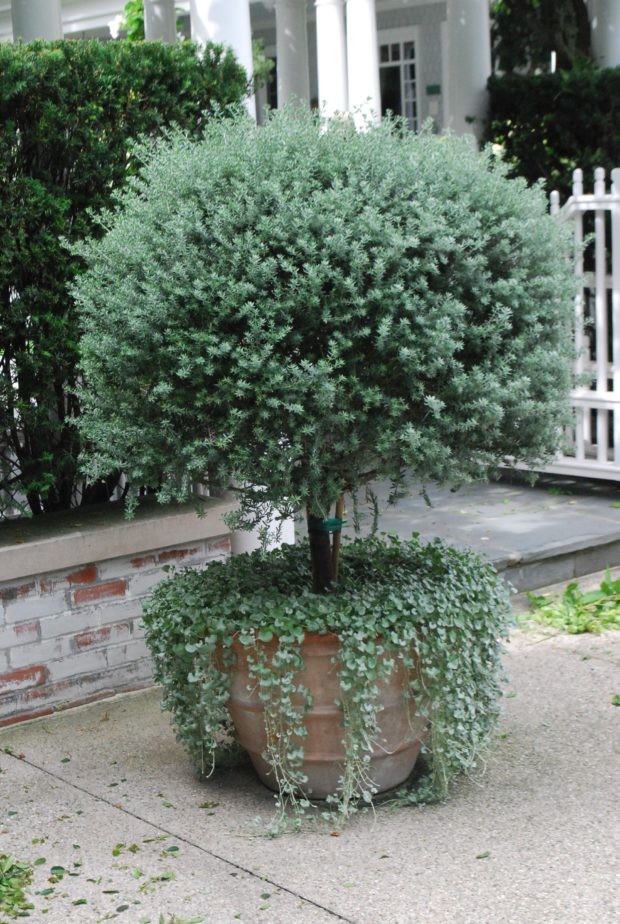 Westringia fructicosa, commonly known as Victorian rosemary, is a dwarf shrub that responds well to development as a topiary. I rarely see it offered for sale, which is unfortunate. This particular single ball topiary made a beautiful container specimen.
Westringia fructicosa, commonly known as Victorian rosemary, is a dwarf shrub that responds well to development as a topiary. I rarely see it offered for sale, which is unfortunate. This particular single ball topiary made a beautiful container specimen.
 Culinary rosemary, or salvia rosemarinus, is a well known subject for topiary. The clippings smell delicious, and its use as an herb is legendary. This particular unsheared topiary is underplanted with fiber optic grass and strawberries.
Culinary rosemary, or salvia rosemarinus, is a well known subject for topiary. The clippings smell delicious, and its use as an herb is legendary. This particular unsheared topiary is underplanted with fiber optic grass and strawberries.
 specimen single ball rosemary on standard
specimen single ball rosemary on standard
 double ball eugenia under planted with begonias
double ball eugenia under planted with begonias
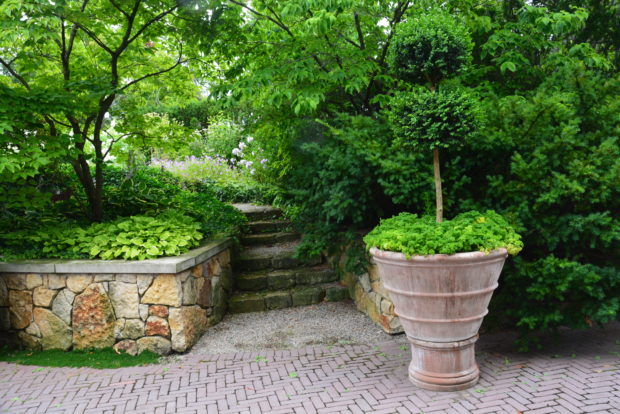 double ball boxwood topiary under planted with curly parsley
double ball boxwood topiary under planted with curly parsley
variegated Algerian ivy topiary
 unsheared double ball rosemary under planted with lettuce and pansies-perfect for a spring container planting.
unsheared double ball rosemary under planted with lettuce and pansies-perfect for a spring container planting.


